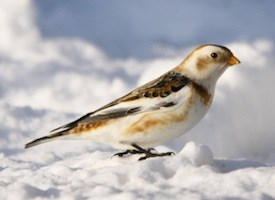 |
Canku Ota
|
 |
|
(Many Paths)
|
||
|
An Online Newsletter
Celebrating Native America
|
||
|
November 2017 - Volume
15 Number 11
|
||
|
|
||
|
Snow Bunting
Plectrophenax nivalis |
||
|
by Cornell Lab of Ornithology
|
||
 Appropriately
named, the Snow Bunting is a bird of the high Arctic and snowy winter
fields. Even on a warm day, the mostly white plumage of a bunting
flock evokes the image of a snowstorm. Appropriately
named, the Snow Bunting is a bird of the high Arctic and snowy winter
fields. Even on a warm day, the mostly white plumage of a bunting
flock evokes the image of a snowstorm.At a Glance
Cool Facts
Breeds on rocky tundra. Winters in open weedy and grassy fields and along shores of lakes and oceans. Food
Weed and grass seeds, insects.
Nest Description Open cup of moss and grass, lined with fine grasses, rootlets, and fur and feathers. Placed well back in cavity in rocks, such as cracks. Nest Placement
Behavior
Walks on ground and pecks at food. May jump up to take seeds from taller stems.
There is little information on Snow Bunting population trends. Partners in Flight estimates a global breeding population of 30 million with 50% spending at least part of the year in Canada, and 25% wintering in the U.S. The species rates a 10 out of 20 on the Continental Concern Score. Snow Bunting is a U.S.-Canada Stewardship species and is listed on the 2014 State of the Birds Report as a Common Bird in Steep Decline.
You Might Also Like: Snowbird Season. Story and photographs in Living Bird magazine. |
|||||||||||||||||||||||||||||||||||||||
|
|
|
||
|
|
||
| Canku Ota is a free Newsletter celebrating Native America, its traditions and accomplishments . We do not provide subscriber or visitor names to anyone. Some articles presented in Canku Ota may contain copyright material. We have received appropriate permissions for republishing any articles. Material appearing here is distributed without profit or monetary gain to those who have expressed an interest. This is in accordance with Title 17 U.S.C. Section 107. | ||
|
Canku Ota is a copyright ©
2000 - 2017 of Vicki Williams Barry and Paul Barry.
|
||
 |
 |
|
|
The "Canku
Ota - A Newsletter Celebrating Native America" web site and
its design is the
|
||
|
Copyright ©
1999 - 2017 of Paul C. Barry.
|
||
|
All Rights Reserved.
|
||





